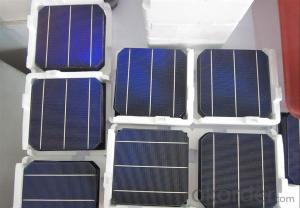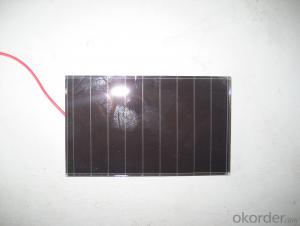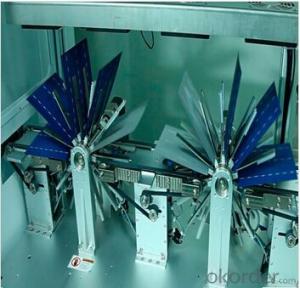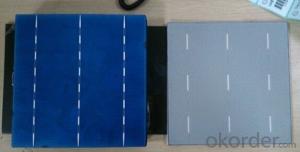Solar Cell High Quality A Grade Cell Polyrystalline 5v 16.4%
- Loading Port:
- Shanghai
- Payment Terms:
- TT OR LC
- Min Order Qty:
- 1000 pc
- Supply Capability:
- 100000 pc/month
OKorder Service Pledge
OKorder Financial Service
You Might Also Like
Specifications
hot sale solar cell
1.16.8%~18.25% high efficiency
2.100% checked quality
3.ISO9001/ISO14001/TUV/CE/UL
4.stable performance
We can offer you the best quality products and services, don't miss !
POLY6'(156*156)
Polycrystalline Silicon Solar cell
Physical Characteristics
Dimension: 156mm×156mm±0.5mm
Diagonal: 220mm±0.5mm
Thickness(Si): 200±20 μm
Front(-) Back(+)
Blue anti-reflecting coating (silicon nitride); Aluminum back surface field;
1.5mm wide bus bars; 2.0mm wide soldering pads;
Distance between bus bars: 51mm . Distance between bus bars :51mm .
Electrical Characteristics
Efficiency(%) | 18.00 | 17.80 | 17.60 | 17.40 | 17.20 | 16.80 | 16.60 | 16.40 | 16.20 | 16.00 | 15.80 | 15.60 |
Pmpp(W) | 4.33 | 4.29 | 4.24 | 4.19 | 4.14 | 4.09 | 4.04 | 3.99 | 3.94 | 3.90 | 3.86 | 3.82 |
Umpp(V) | 0.530 | 0.527 | 0.524 | 0.521 | 0.518 | 0.516 | 0.514 | 0.511 | 0.509 | 0.506 | 0.503 | 0.501 |
Impp(A) | 8.159 | 8.126 | 8.081 | 8.035 | 7.990 | 7.938 | 7.876 | 7.813 | 7.754 | 7.698 | 7.642 | 7.586 |
Uoc(V) | 0.633 | 0.631 | 0.628 | 0.625 | 0.623 | 0.620 | 0.618 | 0.617 | 0.615 | 0.613 | 0.611 | 0.609 |
Isc(A) | 8.709 | 8.677 | 8.629 | 8.578 | 8.531 | 8.478 | 8.419 | 8.356 | 8.289 | 8.220 | 8.151 | 8.083 |
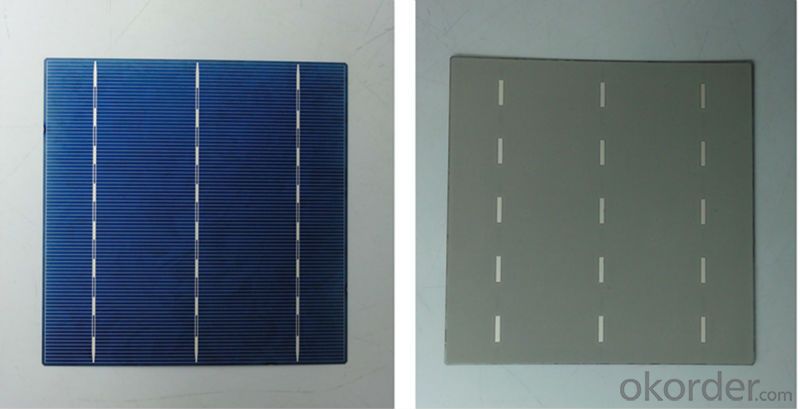
MONO5'(125*125mm)165
Monocrystalline silicon solar cell
Physical Characteristics
Dimension: 125mm×125mm±0.5mm
Diagonal: 165mm±0.5mm
Thickness(Si): 200±20 μm
Front(-) Back(+)
Blue anti-reflecting coating(silicon nitride); Aluminum back surface field;
1.6mmwide bus bars; 2.5mm wide soldering pads;
Distance between bus bars: 61mm . Distance between bus bars :61mm .
Electrical Characteristics
Efficiency(%) | 19.40 | 19.20 | 19.00 | 18.80 | 18.60 | 18.40 | 18.20 | 18.00 | 17.80 | 17.60 | 17.40 | 17.20 |
Pmpp(W) | 2.97 | 2.94 | 2.91 | 2.88 | 2.85 | 2.82 | 2.79 | 2.76 | 2.73 | 2.70 | 2.67 | 2.62 |
Umpp(V) | 0.537 | 0.535 | 0.533 | 0.531 | 0.527 | 0.524 | 0.521 | 0.518 | 0.516 | 0.515 | 0.513 | 0.509 |
Impp(A) | 5.531 | 5.495 | 5.460 | 5.424 | 5.408 | 5.382 | 5.355 | 5.328 | 5.291 | 5.243 | 5.195 | 4.147 |
Uoc(V) | 0.637 | 0.637 | 0.636 | 0.635 | 0.633 | 0.630 | 0.629 | 0.629 | 0.628 | 0.626 | 0.626 | 0.625 |
Isc(A) | 5.888 | 5.876 | 5.862 | 5.848 | 5.839 | 5.826 | 5.809 | 5.791 | 5.779 | 5.756 | 5.293 | 5.144 |

FAQ:
Q:How can i get some sample?
A:Yes , if you want order ,sample is not a problem.
Q:How about your solar panel efficency?
A: Our product efficency around 17.25%~18.25%.
Q:What’s the certificate you have got?
A: we have overall product certificate of ISO9001/ISO14001/CE/TUV/UL
- Q:Can solar silicon wafers be used in solar-powered military applications?
- Yes, solar silicon wafers can be used in solar-powered military applications. They are commonly used in various military systems, including remote surveillance equipment, communication devices, and portable power solutions for soldiers in the field. Solar-powered military applications benefit from the reliability, durability, and energy efficiency of solar silicon wafers, making them a viable option for sustainable power generation in military operations.
- Q:How are solar silicon wafers protected from water damage?
- Solar silicon wafers are protected from water damage through a combination of encapsulation and sealing techniques. The wafers are typically coated with a thin layer of protective material, such as glass or a polymer, which acts as a barrier against water penetration. Additionally, the edges of the wafers are sealed to prevent any water ingress. These protective measures ensure that the wafers remain resistant to water damage, allowing them to function effectively in outdoor environments.
- Q:How is a microinverter integrated into a solar silicon wafer?
- A microinverter is not directly integrated into a solar silicon wafer. Instead, a microinverter is typically installed on the back of each individual solar panel in a solar array. It converts the DC (direct current) power generated by the solar panel into AC (alternating current) power that can be used to power household appliances or be fed back into the electrical grid.
- Q:How are solar silicon wafers protected from fire hazards?
- Solar silicon wafers are typically protected from fire hazards through the use of fire-resistant encapsulation materials and manufacturing processes. These encapsulation materials, such as glass or special polymers, provide a protective barrier around the silicon wafer, preventing it from being exposed to direct flame or heat sources. Additionally, stringent quality control measures are implemented during the manufacturing process to ensure that the wafers are not vulnerable to ignition or combustion.
- Q:Can solar silicon wafers be used in other applications besides solar panels?
- Yes, solar silicon wafers can be used in other applications besides solar panels. They are also commonly used in the production of semiconductors, integrated circuits, and various electronic devices due to their excellent electrical properties and high purity.
- Q:What is the impact of impurities on the efficiency of solar silicon wafers?
- The presence of impurities in solar silicon wafers can have a significant impact on their efficiency. Impurities can disrupt the crystal lattice structure of the silicon, affecting its electrical conductivity and optical properties. This can lead to reduced conversion of sunlight into electricity and increased energy losses within the solar cell. Additionally, impurities can introduce charge carrier recombination centers, which hinder the movement of electrons and holes, further reducing the efficiency of the solar cell. Therefore, minimizing impurities and ensuring high purity of the silicon material is crucial for maximizing the efficiency of solar silicon wafers.
- Q:What is the expected efficiency improvement for multi-junction solar silicon wafers?
- The expected efficiency improvement for multi-junction solar silicon wafers is significant. These wafers have the potential to achieve much higher efficiency levels compared to traditional single-junction solar cells. By incorporating multiple layers of different semiconductor materials, multi-junction wafers can capture a broader range of the solar spectrum and convert sunlight into electricity more efficiently. Current research and development efforts indicate that multi-junction solar silicon wafers could potentially achieve efficiencies of over 40%, compared to around 20% for conventional silicon solar cells. This improvement in efficiency holds great promise for enhancing the performance and cost-effectiveness of solar energy systems.
- Q:I work in a solar cell company, do silicon chip testing on the human body what chronic harm?
- If it is at least module, such as CVD PVD, there are some toxic gases
- Q:Can solar silicon wafers be recycled?
- Yes, solar silicon wafers can be recycled. The recycling process involves reclaiming valuable materials such as silicon, silver, and other metals from the wafers, which can then be used to produce new solar panels or other electronic devices. Recycling solar silicon wafers reduces waste and conserves resources, making it an environmentally sustainable practice.
- Q:What are the main factors that affect the lifespan of a solar silicon wafer?
- The main factors that affect the lifespan of a solar silicon wafer are material degradation, environmental conditions, and manufacturing defects. Material degradation refers to the gradual breakdown of the silicon material due to various factors such as heat, light exposure, and chemical reactions. Environmental conditions such as temperature, humidity, and exposure to harsh weather elements can also impact the wafer's lifespan. Additionally, manufacturing defects, such as impurities or flaws introduced during the fabrication process, can affect the wafer's performance and longevity.
1. Manufacturer Overview |
|
|---|---|
| Location | |
| Year Established | |
| Annual Output Value | |
| Main Markets | |
| Company Certifications | |
2. Manufacturer Certificates |
|
|---|---|
| a) Certification Name | |
| Range | |
| Reference | |
| Validity Period | |
3. Manufacturer Capability |
|
|---|---|
| a)Trade Capacity | |
| Nearest Port | |
| Export Percentage | |
| No.of Employees in Trade Department | |
| Language Spoken: | |
| b)Factory Information | |
| Factory Size: | |
| No. of Production Lines | |
| Contract Manufacturing | |
| Product Price Range | |
Send your message to us
Solar Cell High Quality A Grade Cell Polyrystalline 5v 16.4%
- Loading Port:
- Shanghai
- Payment Terms:
- TT OR LC
- Min Order Qty:
- 1000 pc
- Supply Capability:
- 100000 pc/month
OKorder Service Pledge
OKorder Financial Service
Similar products
New products
Hot products
Hot Searches
Related keywords
